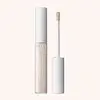What's inside
What's inside
 Key Ingredients
Key Ingredients

 Benefits
Benefits

 Concerns
Concerns

 Ingredients Side-by-side
Ingredients Side-by-side

Water
Skin ConditioningCyclopentasiloxane
EmollientHydrogenated Polyisobutene
EmollientSorbitan Isostearate
EmulsifyingGlycerin
HumectantPropanediol
SolventPropylene Glycol
HumectantAlumina
AbrasiveOzokerite
Emulsion StabilisingPhenoxyethanol
PreservativeMagnesium Sulfate
Disodium Stearoyl Glutamate
CleansingSynthetic Fluorphlogopite
Disteardimonium Hectorite
StabilisingCaprylyl Glycol
EmollientAcrylonitrile/Methyl Methacrylate/Vinylidene Chloride Copolymer
Aluminum Hydroxide
EmollientTocopherol
AntioxidantDisodium EDTA
Isobutane
Tin Oxide
AbrasiveCI 77891
Cosmetic ColorantCI 77491
Cosmetic ColorantCI 77492
Cosmetic ColorantCI 77499
Cosmetic ColorantWater, Cyclopentasiloxane, Hydrogenated Polyisobutene, Sorbitan Isostearate, Glycerin, Propanediol, Propylene Glycol, Alumina, Ozokerite, Phenoxyethanol, Magnesium Sulfate, Disodium Stearoyl Glutamate, Synthetic Fluorphlogopite, Disteardimonium Hectorite, Caprylyl Glycol, Acrylonitrile/Methyl Methacrylate/Vinylidene Chloride Copolymer, Aluminum Hydroxide, Tocopherol, Disodium EDTA, Isobutane, Tin Oxide, CI 77891, CI 77491, CI 77492, CI 77499
Water
Skin ConditioningDimethicone
EmollientPolymethyl Methacrylate
Polymethylsilsesquioxane
Methyl Trimethicone
Skin ConditioningPEG-10 Dimethicone
Skin ConditioningGlycerin
HumectantButylene Glycol
HumectantAcrylates/Dimethicone Copolymer
Skin ConditioningSodium Potassium Aluminum Silicate
PEG/PPG-18/18 Dimethicone
EmulsifyingSodium Chloride
MaskingTrimethylsiloxysilicate
EmollientCaprylyl Dimethicone Ethoxy Glucoside
EmulsifyingDisteardimonium Hectorite
StabilisingTriethyl Citrate
MaskingSilica
AbrasiveDimethicone Crosspolymer
Emulsion StabilisingTriethoxycaprylylsilane
Tocopheryl Acetate
AntioxidantAluminum Hydroxide
EmollientDisodium EDTA
Bacillus/Soybean Ferment Extract
Skin ConditioningPhenoxyethanol
PreservativePotassium Sorbate
PreservativeSodium Dehydroacetate
PreservativeCI 77891
Cosmetic ColorantCI 77491
Cosmetic ColorantCI 77492
Cosmetic ColorantCI 77499
Cosmetic ColorantWater, Dimethicone, Polymethyl Methacrylate, Polymethylsilsesquioxane, Methyl Trimethicone, PEG-10 Dimethicone, Glycerin, Butylene Glycol, Acrylates/Dimethicone Copolymer, Sodium Potassium Aluminum Silicate, PEG/PPG-18/18 Dimethicone, Sodium Chloride, Trimethylsiloxysilicate, Caprylyl Dimethicone Ethoxy Glucoside, Disteardimonium Hectorite, Triethyl Citrate, Silica, Dimethicone Crosspolymer, Triethoxycaprylylsilane, Tocopheryl Acetate, Aluminum Hydroxide, Disodium EDTA, Bacillus/Soybean Ferment Extract, Phenoxyethanol, Potassium Sorbate, Sodium Dehydroacetate, CI 77891, CI 77491, CI 77492, CI 77499
Ingredients Explained
These ingredients are found in both products.
Ingredients higher up in an ingredient list are typically present in a larger amount.
Aluminum Hydroxide is a form of aluminum. It can be naturally found in nature as the mineral gibbsite. In cosmetics, Aluminum Hydroxide is used as a colorant, pH adjuster, and absorbent.
As a colorant, Aluminum Hydroxide may add opacity, or reduce the transparency. Aluminum hydroxide is contains both basic and acidic properties.
According to manufacturers, this ingredient is an emollient and humectant. This means it helps hydrate the skin.
In medicine, this ingredient is used to help relieve heartburn and help heal ulcers.
There is currently no credible scientific evidence linking aluminum hydroxide in cosmetics to increased cancer risk.
Major health organizations allow the use of aluminum hydroxide in personal care products and have not flagged it as a carcinogenic risk at typical usage levels.
Learn more about Aluminum HydroxideCi 77491 is also hydrated iron III oxide. It's sole purpose is to give a red/pink hue to products.
Iron III oxides are classified as inorganic chemicals for coloring.
Synthetically created Ci 77491 is considered safer than those naturally found. This is because the synthetically created version may contain less impurities. Iron oxides are generally non-toxic and non-allergenic.
Learn more about CI 77491Ci 77492 is also hydrated iron III oxide. It's sole purpose is to give a yellow hue to products.
Iron III oxides are classified as inorganic chemicals for coloring.
Synthetically created Ci 77492 is considered safer than those naturally found. This is because the synthetically created version may contain less impurities. Iron oxides are generally non-toxic and non-allergenic.
Learn more about CI 77492Ci 77499 is also hydrated iron III oxide. It is created from mixing red and black iron oxides. This helps give shades of darkness to a product.
Iron III oxides are classified as inorganic chemicals for coloring.
Ci 77891 is a white pigment from Titanium dioxide. It is naturally found in minerals such as rutile and ilmenite.
It's main function is to add a white color to cosmetics. It can also be mixed with other colors to create different shades.
Ci 77891 is commonly found in sunscreens due to its ability to block UV rays.
Learn more about CI 77891Disodium EDTA plays a role in making products more stable by aiding other preservatives.
It is a chelating agent, meaning it neutralizes metal ions that may be found in a product.
Disodium EDTA is a salt of edetic acid and is found to be safe in cosmetic ingredients.
Learn more about Disodium EDTADisteardimonium Hectorite comes from the clay mineral named hectorite. It is used to add thickness to a product.
It can also help stabilize a product by helping to disperse other ingredients.
Hectorite is a rare, white clay mineral.
Learn more about Disteardimonium HectoriteGlycerin is already naturally found in your skin. It helps moisturize and protect your skin.
A study from 2016 found glycerin to be more effective as a humectant than AHAs and hyaluronic acid.
As a humectant, it helps the skin stay hydrated by pulling moisture to your skin. The low molecular weight of glycerin allows it to pull moisture into the deeper layers of your skin.
Hydrated skin improves your skin barrier; Your skin barrier helps protect against irritants and bacteria.
Glycerin has also been found to have antimicrobial and antiviral properties. Due to these properties, glycerin is often used in wound and burn treatments.
In cosmetics, glycerin is usually derived from plants such as soybean or palm. However, it can also be sourced from animals, such as tallow or animal fat.
This ingredient is organic, colorless, odorless, and non-toxic.
Glycerin is the name for this ingredient in American English. British English uses Glycerol/Glycerine.
Learn more about GlycerinPhenoxyethanol is a preservative that has germicide, antimicrobial, and aromatic properties. Studies show that phenoxyethanol can prevent microbial growth. By itself, it has a scent that is similar to that of a rose.
It's often used in formulations along with Caprylyl Glycol to preserve the shelf life of products.
Water. It's the most common cosmetic ingredient of all. You'll usually see it at the top of ingredient lists, meaning that it makes up the largest part of the product.
So why is it so popular? Water most often acts as a solvent - this means that it helps dissolve other ingredients into the formulation.
You'll also recognize water as that liquid we all need to stay alive. If you see this, drink a glass of water. Stay hydrated!
Learn more about Water